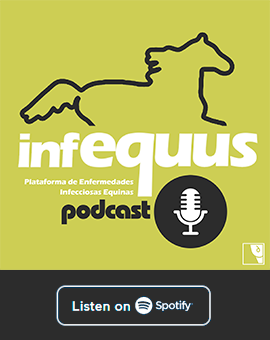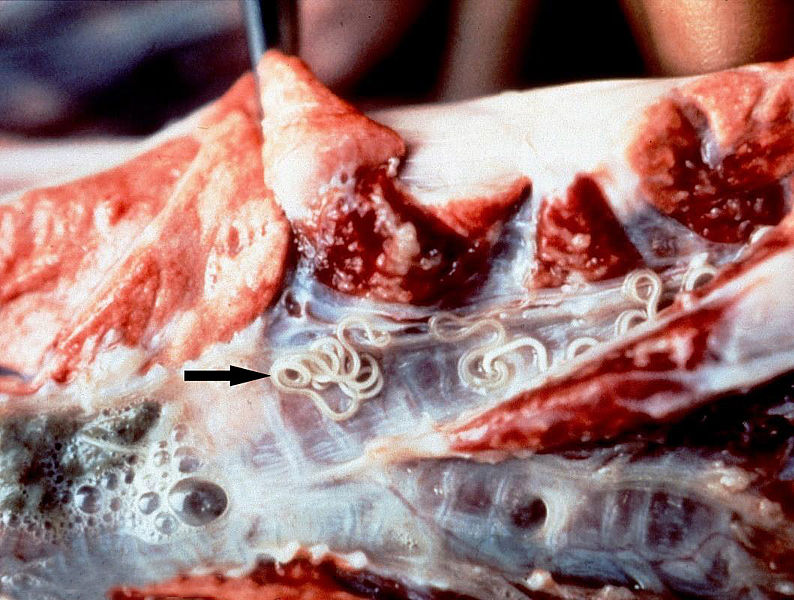Dictyocaulosis
Etiology
Parasitic nematode of the order Strongylidae that infests the lungs of equines. Donkeys and mules are the main reservoir hosts and they act as a reservoir for horses. This parasite is often present in horses that have been in contact with donkeys and mules, although direct horse-to-horse spread is possible. Adult Dictyocaulus worms are slender, whitish to grayish color, up to 8 centimeter long with their body covered with a cuticle.
Epidemiology
Dictyocaulus worms have a direct lifecycle. Infection is initiated by ingestion of L3 by grassing. These larvae migrate through the gut wall, they molt to L4 in the lymphatic nodules and they reach the bronchioles where they molt to L5 or preadult. The L5 ascend to the trachea and the bronchi and they complete development to adult worms. Adult females lay eggs, which are transported to the pharynx within respiratory secretions. From the pharynx, these eggs are coughed out, directly to the outside or into the mouth to be swallowed. If eggs are swallowed, L1 is released in the gut and shed in the feces. In the environment, L1 is developed to infective L3 larva in about 1 week. The prepatent period is about 4 weeks. However, L5 hypobiosis can occur (the L5 ingested at the end of autumn / winter can remain inhibited in the lungs for 5 months, resuming its development in the following spring). Some studies suggest the Pilobolus fungi may play a role in the spread of D. arnfieldi larvae, because of these fungi grow on manure. Infective L3 larvae invade the sporangia and are dispersed in the environment when sporangia rupture.
Pathogeny
Larvae migrating through the alveoli and bronchioles produce an inflammatory response. The bronchi and bronchioles may be blocked because of the presence of adults worms and inflammatory exudates. During the prepatent period, the bronchioles are blocked by eosinophilic exudates. Adult worms cause bronchitis and a primary pneumonia can occur during the patent stage. Throughout the necropsy, atelectasis, emphysema and petechial hemorrhage may be present in the lungs. Secondary bacterial pneumonia and viral infections are complication of Dictyocaulosis.
Clinical signs
Overt clinical signs are rarely seen. Horses usually present persistent coughing and an increased expiratory effort. Auscultation frequently reveals crackles and wheezes. Chronic obstructive pulmonary disease (COPD), chronic hypersensitivity pneumonitis, fungal pneumonia and foreign body in the trachea may be a differential diagnosis.
Diagnosis
Endoscopy and radiography may be helpful. Endoscopic examination usually reveals large quantities of exudates in the large airways, with a preponderance of eosinophils. On rare occasions, adult lungworms may be visualized in the bronchi. Larval stages may be observed in tracheal wash or bronchoalveolar lavage samples or in centrifuged mucus. L1 can be identified with the coprologic examination (modification of Baermann technique). There are also serological tests (ELISA) for the detection of antibodies against these parasites.
Treatment
Moxidectin and ivermectin are effective against D. arnfieldi. Benzimidazoles may also be effective for treatment, although fenbendazole only transiently suppressed fecal larval counts.
Prevention and control
Avoid stabling and grazing together donkeys and horses. If this cannot be possible, deworming would be a very important prevention measure. Alternate grazing with other animal species such as cattle, sheep and goats can help reduce infection because Dictyocaulus species are quiet host-specific. Pasture contamination with infective larvae may be reduced by keeping the pastures empty for at least 40 days since larvae cannot survive more than 4 or 5 days on pasture if they do not find an adequate host. Keeping the pastures as dry as possible and keeping the animals away from places excessively humid would be additional measures to reduce the exposure of animals to infective larvae.
Public Health Considerations
Dictyocaulus arnfieldi is not a zoonotic disease and it is not included in the notifiable diseases OIE list.
References
- Equine Infectious Diseases. 2014 Elsevier Inc. ISBN: 978-1-4557-0891-8
- Lungworm: (Dictyocaulus arnfieldi) infection in donkeys
- Equine Lung Worm: A Systematic Review


